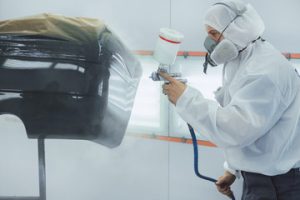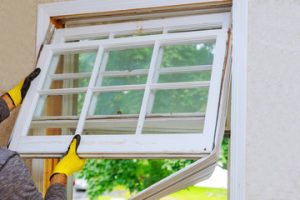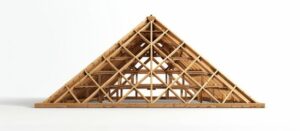Fiberglass is a great material to use for auto body repairs. It’s lightweight, durable and doesn’t rust like traditional metal panels.

However, it’s not indestructible and can be damaged from impacts or environmental exposure. This can lead to cracks or delamination that require expert repair. The process of repairing fiberglass is complex and time-consuming. Keep reading the article below to learn more about Fiberglass Auto Body Repair.
Fiberglass auto body repair is a process that takes time and patience, but it can be done well by those with the right tools and skills. A student in an automotive service technician program may want to learn how to make fiberglass repairs as part of his or her education. While fiberglass may not be as durable as metal, it is lightweight and can offer a sleek look to a car’s body.
While working with fiberglass, it is important to remember that the material looks different on each side of a panel. This makes it difficult to tell if a crack has spread from the inside or outside of the panel. This problem is often solved by screwing a piece of metal backer onto the underside of the panel before filling it. This helps to strengthen the crack and protects it from water damage.
Once the crack is filled, a sanding job must be made to remove any rough spots and smooth the area. It is helpful to use heavy grit sandpaper in order to achieve the best results. A block sander can also be used to ensure that the filler is completely level with the surrounding fiberglass.
The edges of the repaired area must be taped. This will prevent any fiberglass resin from leaking out of the repaired area. After the sanding is complete, the repaired area must be cleaned using a clean, low VOC-compliant cleaner and allowed to dry before beginning the next step of the process.
A good quality resin is essential for successful fiberglass repairs. One option is Bondo Glass Reinforced Filler, which is designed for fiberglass-quality repair of dime size or smaller rust-outs without the need for backing strips or fiberglass mat. This type of filler contains short, interlocking fiberglass strands that provide twice the strength of traditional body filler and can be sanded down to a high-quality finish.
Another option for fiberglass auto body repair is gelcoat. This is a thick coating that provides a high-quality finish and protects the repaired surface from abrasions. Students who choose this method should practice using a small piece of the damaged panel before applying it to the larger vehicle. The use of a gelcoat on fiberglass can be challenging because it requires a different spray gun than normal paint.
Filling
The next step of the fiberglass repair process involves patching holes and restoring the shape of the damaged area. To do this, the affected area is sanded down to a rough surface and cleaned with acetone. Once the area is clean and dry, it’s ready for the first layer of fiberglass. The process is similar to that of welding, but instead of using a metal jig or clamps, the fiberglass is shaped by hand and with a hammer. This is an advanced technique, but if done correctly can produce high-quality results.
Once the fiberglass is shaped, it’s bonded to the vehicle with polyester body filler, which bonds to fiberglass and metals as well. Multiple thin coats are applied with a rubber spreading card to achieve a smooth surface. The area is then wet-sanded with 400 grit wet/dry sandpaper and wiped down with acetone. This is a time-consuming step, but the results are worth it.
After the fiberglass and body filler have cured, it’s time to add the finishing touches. This is where the car’s original appearance and strength are restored. Unlike steel, fiberglass is resistant to impact, which makes it an ideal material for vehicle bodies and bumpers. It’s also flexible, which allows it to conform to the original shape of the vehicle. In addition, fiberglass is easy to work with and can be molded into many different colors.
While repairing fiberglass can be difficult, with the right tools and a little practice you can learn how to do it on your own. However, if you’re not confident in your abilities or are unsure how to start, it may be a good idea to take your vehicle to an auto body shop for a professional repair. The experienced technicians at Exotic Motors can fix any type of damage to your vehicle’s frame or body, restoring the original strength and beauty. Visit us today for a free estimate!
Bonding
Fiberglass is a versatile material, often used in auto body construction because of its strength-to-weight ratio. It’s also highly flexible, making it ideal for forming complex shapes that make cars aerodynamically efficient. However, fiberglass is not indestructible and can be damaged over time due to impacts or extreme stress. This damage may take the form of cracks, holes, or delamination. These problems require professional repairs. Juanito’s auto body experts will thoroughly inspect your car to determine the extent of the damage and recommend a suitable repair.
To perform a successful fiberglass repair, it’s important to understand how the process works. This will help you avoid common mistakes and make the most of your repair. For instance, you must make sure that the resin and actuator are mixed well. Moreover, you should be prepared to work fast, as the resin will begin to harden in less than 30 minutes.
For the best results, it’s a good idea to use a fiberglass epoxy, such as Bondo(r). This is a do-it-yourself kit that includes cloth and resin for straightforward application over cracks or metal rust-outs. It also adheres to most metals and hardens to a sandable surface in less than two hours.
Once the repair is complete, it’s important to sand the area with a high-grit sandpaper to create a smooth and even finish. Once you’ve sanded the area, wipe it down with acetone to remove any dirt or grease that may interfere with the adhesion of your new fiberglass. Finally, apply a thin layer of your chosen primer and wait for it to dry completely.
While fiberglass is a great material for repairing car bodies, it can be difficult to get the right mix of materials for the job. For example, it’s impossible to replicate the internal strength of the original fiberglass when patching a crack. When using panel bond, it’s important to remember that the adhesive only adheres to the old resin – not to the fiberglass itself. This can leave a repaired area stronger or weaker than the original fiberglass. In addition, the new resin is likely to have a different mix of polymers than the original fiberglass.
Finishing
Fiberglass is a strong and lightweight material that can be used to create a wide variety of auto body parts. It is also a popular choice for car bodies because it can be easily shaped and painted to match the original appearance of a vehicle. However, fiberglass requires special care to keep it looking its best. If you are an automotive student, or interested in pursuing a career in the trades, learning how to perform fiberglass repair is a valuable skill.
Before you can begin to fix a crack or hole in your fiberglass auto body, it is important to prepare the surface for bonding. Start by sanding the area, using coarse grit to create a mechanical connection between the fiberglass and the metal body panel. Then, wipe down the area with acetone or another degreaser to remove any dirt or grease. Next, apply a coat of fiberglass resin to the surface. After letting it dry, sand the resin down until it is smooth and clean. If there are any blemishes, use spot putty to cover them.
After the resin has dried, you can attach fiberglass cloth to the surface. Fiberglass cloth comes in different thicknesses and types, each of which is suited for a specific type of repair. For example, fiberglass mat is ideal for repairing small holes and channels, while fiberglass woven cloth is better for larger areas.
Once you have attached the fiberglass, you can sand the surface again to remove any blemishes. Then, it is time to finish the repair. This is where the process really becomes advanced, as it involves a mix of techniques and materials that can make the repaired fiberglass section as good as—if not stronger than—the original piece.
For example, a common technique involves screwing a piece of metal to the underside of a fiberglass hole or crack. This helps to lock the new fiberglass in place and prevent it from being pushed out by future vibrations. For this reason, the proper assessment of the damage is vital, as not all fiberglass cracks are immediately obvious. If the crack is hidden, you can test it by tapping it with a tool and listening for a dull sound.



